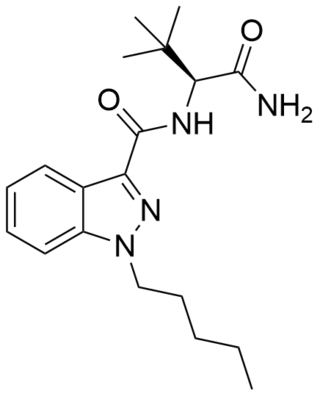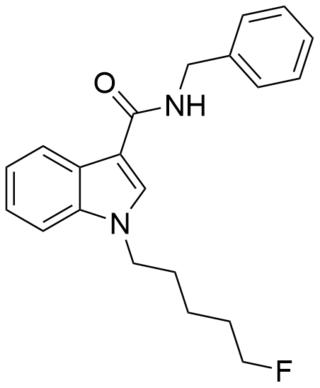The molecular formula C22H25N3O (molar mass: 347.45 g/mol, exact mass: 347.1998 u) may refer to:

APINACA (AKB48, N-(1-adamantyl)-1-pentyl-1H-indazole-3-carboxamide) is a drug that acts as a reasonably potent agonist for the cannabinoid receptors. It is a full agonist at CB1 with an EC50 of 142 nM and Ki of 3.24 nM (compared to the Ki of Δ9-THC at 28.35 nM and JWH-018 at 9.62 nM), while at CB2 it acts as a partial agonist with an EC50 of 141 nM and Ki of 1.68 nM (compared to the Ki of Δ9-THC at 37.82 nM and JWH-018 at 8.55 nM). Its pharmacological characterization has also been reported in a discontinued patent application. It had never previously been reported in the scientific or patent literature, and was first identified by laboratories in Japan in March 2012 as an ingredient in synthetic cannabis smoking blends, along with a related compound APICA. Structurally, it closely resembles cannabinoid compounds from a University of Connecticut patent, but with a simple pentyl chain on the indazole 1-position, and APINACA falls within the claims of this patent despite not being disclosed as an example.

APICA is an indole based drug that acts as a potent agonist for the cannabinoid receptors.

AB-FUBINACA (AMB-FUBINACA) is a psychoactive drug that acts as a potent agonist for the cannabinoid receptors, with Ki values of 0.9 nM at CB1 and 23.2 nM at CB2 and EC50 values of 1.8 nM at CB1 and 3.2 nM at CB2. It was originally developed by Pfizer in 2009 as an analgesic medication but was never pursued for human use. In 2012, it was discovered as an ingredient in synthetic cannabinoid blends in Japan, along with a related compound AB-PINACA, which had not previously been reported.

SDB-006 is a drug that acts as a potent agonist for the cannabinoid receptors, with an EC50 of 19 nM for human CB2 receptors, and 134 nM for human CB1 receptors. It was discovered during research into the related compound SDB-001 which had been sold illicitly as "2NE1". SDB-006 metabolism has been described in literature.

AB-CHMINACA is an indazole-based synthetic cannabinoid. It is a potent agonist of the CB1 receptor (Ki = 0.78 nM) and CB2 receptor (Ki = 0.45 nM) and fully substitutes for Δ9-THC in rat discrimination studies, while being 16x more potent. Continuing the trend seen in other cannabinoids of this generation, such as AB-FUBINACA and AB-PINACA, it contains a valine amino acid amide residue as part of its structure, where older cannabinoids contained a naphthyl or adamantane residue.

ADB-PINACA is a cannabinoid designer drug that is an ingredient in some synthetic cannabis products. It is a potent agonist of the CB1 receptor and CB2 receptor with EC50 values of 0.52 nM and 0.88 nM respectively. Like MDMB-FUBINACA, this compound incorporates the unnatural amino acid tert-leucine.

THJ-2201 is an indazole-based synthetic cannabinoid that presumably acts as a potent agonist of the CB1 receptor and has been sold online as a designer drug.

5F-AMB (also known as 5F-MMB-PINACA and 5F-AMB-PINACA) is an indazole-based synthetic cannabinoid from the indazole-3-carboxamide family, which has been used as an active ingredient in synthetic cannabis products. It was first identified in Japan in early 2014. Although only very little pharmacological information about 5F-AMB itself exists, its 4-cyanobutyl analogue (instead of 5-fluoropentyl) has been reported to be a potent agonist for the CB1 receptor (KI = 0.7 nM).

FUBIMINA is a synthetic cannabinoid that is the benzimidazole analog of AM-2201 and has been used as an active ingredient in synthetic cannabis products. It was first identified in Japan in 2013, alongside MEPIRAPIM.

5F-SDB-006 is a drug that acts as a potent agonist for the cannabinoid receptors, with an EC50 of 50 nM for human CB1 receptors, and 123 nM for human CB2 receptors. It was discovered during research into the related compound APICA which had been sold illicitly as "2NE1". 5F-SDB-006 is the terminally fluorinated analog of SDB-006, just as STS-135 is the terminally fluorinated analog of APICA. Given the known metabolic liberation (and presence as an impurity) of amantadine in the related compound APINACA, it is suspected that metabolic hydrolysis of the amide group of 5F-SDB-006 may release benzylamine.

THJ-018 (SGT-17) is a synthetic cannabinoid that is the indazole analogue of JWH-018 and has been sold online as a designer drug.

5F-CUMYL-PINACA (also known as SGT-25 and sometimes sold in e-cigarette form as C-Liquid) is an indazole-3-carboxamide based synthetic cannabinoid. 5F-CUMYL-PINACA acts as a potent agonist for the cannabinoid receptors, with the original patent claiming approximately 4x selectivity for CB1, having an EC50 of <0.1 nM for human CB1 receptors and 0.37 nM for human CB2 receptors. In more recent assays using different techniques, 5F-CUMYL-PINACA was variously found to have an EC50 of 0.43 nM at CB1 and 11.3 nM at CB2, suggesting a somewhat higher CB1 selectivity of 26 times, or alternatively 15.1 nM at CB1 and 34.8 nM at CB2 with only 2.3 times selectivity, however these figures cannot be directly compared due to the different assay techniques used in each case.

5F-ADB-PINACA is a cannabinoid designer drug that is an ingredient in some synthetic cannabis products. It is a potent agonist of the CB1 receptor and CB2 receptor with EC50 values of 0.24 nM and 2.1 nM respectively.

FUB-144 (also known as FUB-UR-144) is an indole-based synthetic cannabinoid that is presumed to be a potent agonist of the CB1 receptor and has been sold online as a designer drug. It is an analogue of UR-144 and XLR-11 where the pentyl chain has been replaced with fluorobenzyl.

5F-AB-FUPPYCA (also known as AZ-037) is a pyrazole-based synthetic cannabinoid that is presumed to be an agonist of the CB1 receptor and has been sold online as a designer drug. It was first detected by the EMCDDA as part of a seizure of 540 g white powder in France in February 2015.

5F-EDMB-PINACA is a designer drug and synthetic cannabinoid. In 2018, it was the fourth-most common synthetic cannabinoid identified in drugs seized by the Drug Enforcement Administration.

MDMB-4en-PINACA is an indazole-based synthetic cannabinoid that has been sold online as a designer drug. MDMB-4en-PINACA was first identified in Europe in 2017. In 2021, MDMB-4en-PINACA was the most common synthetic cannabinoid identified by the Drug Enforcement Administration in the United States. MDMB-4en-PINACA differs from 5F-MDMB-PINACA due to replacement of 5-fluoropentyl with a pent-4-ene moiety (4-en).

5F-CUMYL-PEGACLONE (5F-SGT-151, SGT-269) is a gamma-carboline based synthetic cannabinoid that has been sold as a designer drug, first being identified in Germany in 2017. It acts as a potent full agonist of the CB1 receptor. It appears to be more toxic than related compounds such as CUMYL-PEGACLONE, and has been linked to numerous serious adverse reactions, some fatal.


















